These alfajores are made from two soft, cornstarch cookies that are filled with gooey dulce de leche (a caramel-like spread). They're sweet with a melt-in-your-mouth quality. This is the most traditional and perfect recipe of them all. If you never had alfajores, you're in for a treat.
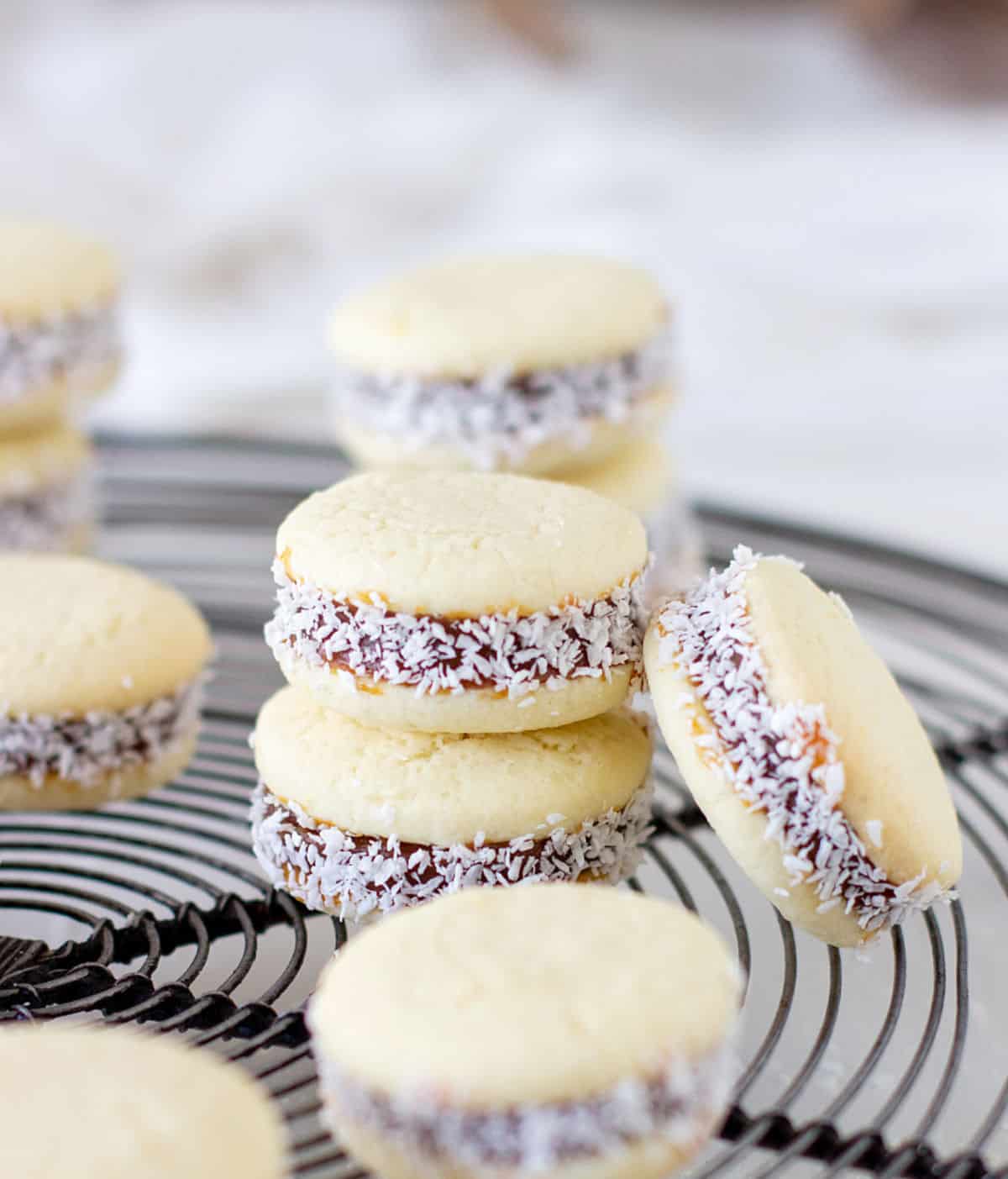
I know alfajores
Alfajores come in many variations, including different fillings, coatings, and shapes. They are often served with coffee or tea and are a popular snack or dessert.
To my knowledge, the oldest that are relevant to this day are these cornstarch alfajores, which are different from these shortbread-style alfajores.
I'm from Argentina, and, as I told you in the post about walnut alfajores, we are the biggest consumers of these sweet snacks worldwide. The array of different options you can buy here is mind-boggling.
So trust me when I say that this is the only recipe you'll ever need for traditional cornstarch alfajores.
The original recipe hails from a 90-year-old cookbook by Doña Petrona (our own Julia Child) and is still the recipe we all adapt. It's sort of like the chocolate chip cookies recipe from Toll House. It's where they all start, isn't it?
Overall, the combination of delicate crumbly texture, subtle flavor and sweet filling is what makes cornstarch alfajores so delicious and beloved by so many.
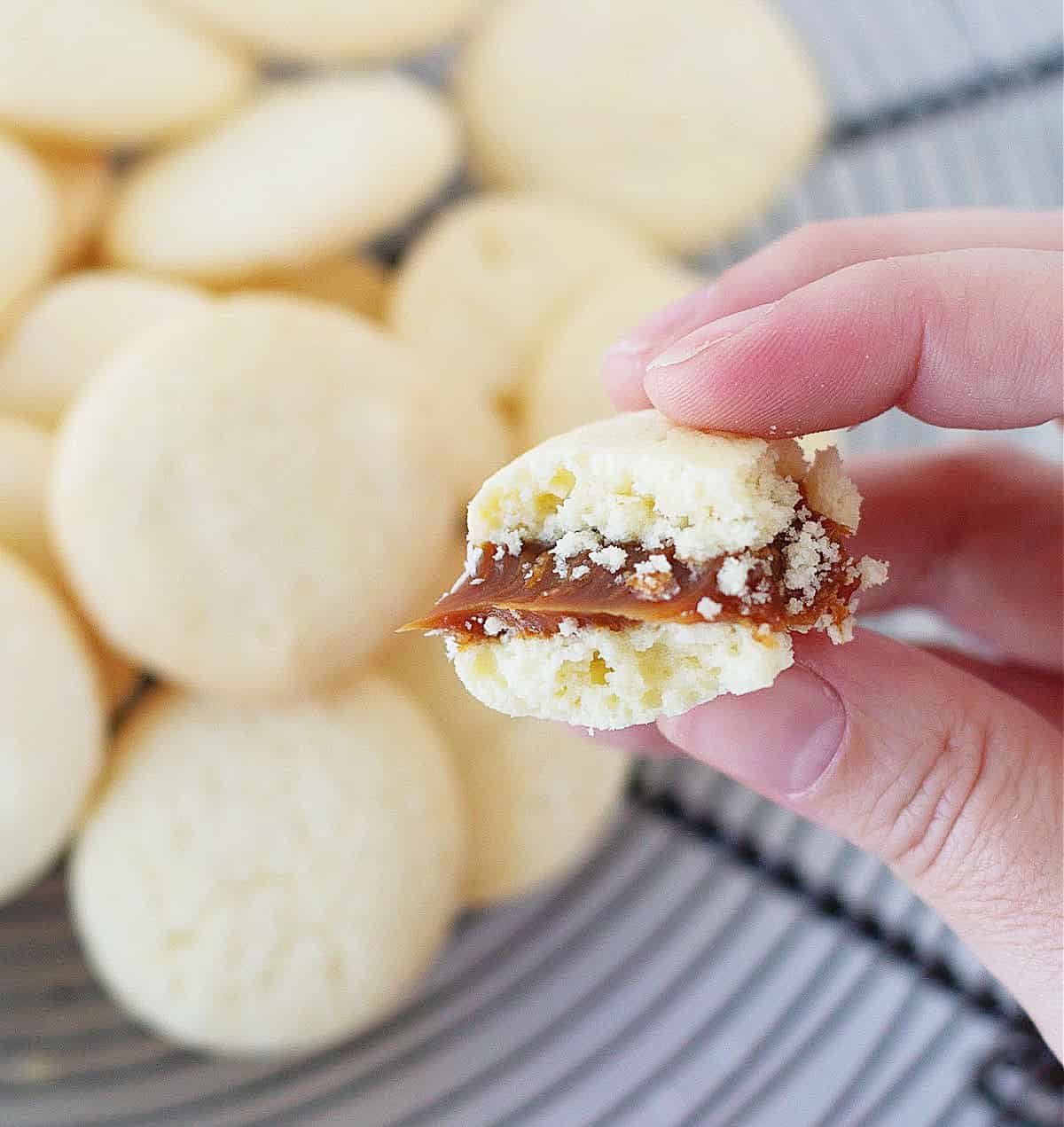
What are alfajores?
An alfajor (singular) is a sandwich made of two discs of dough with a filling in between. It is a sandwich cookie. ALL are filled with dulce de leche unless specified in the name, like chocolate mousse alfajores or quince jam alfajores.
Alfajores have a unique combination of textures and flavors. They are delicate yet rich, crumbly yet creamy, and sweet yet balanced.
They are very popular in South America, especially Argentina, Perú, and Uruguay.
The most in-demand are probably chocolate alfajores because, well, they're chocolate-covered. Then there are shortbread alfajores, which are usually small and great for tea time, with a cup of coffee, or as finger food at a celebration.
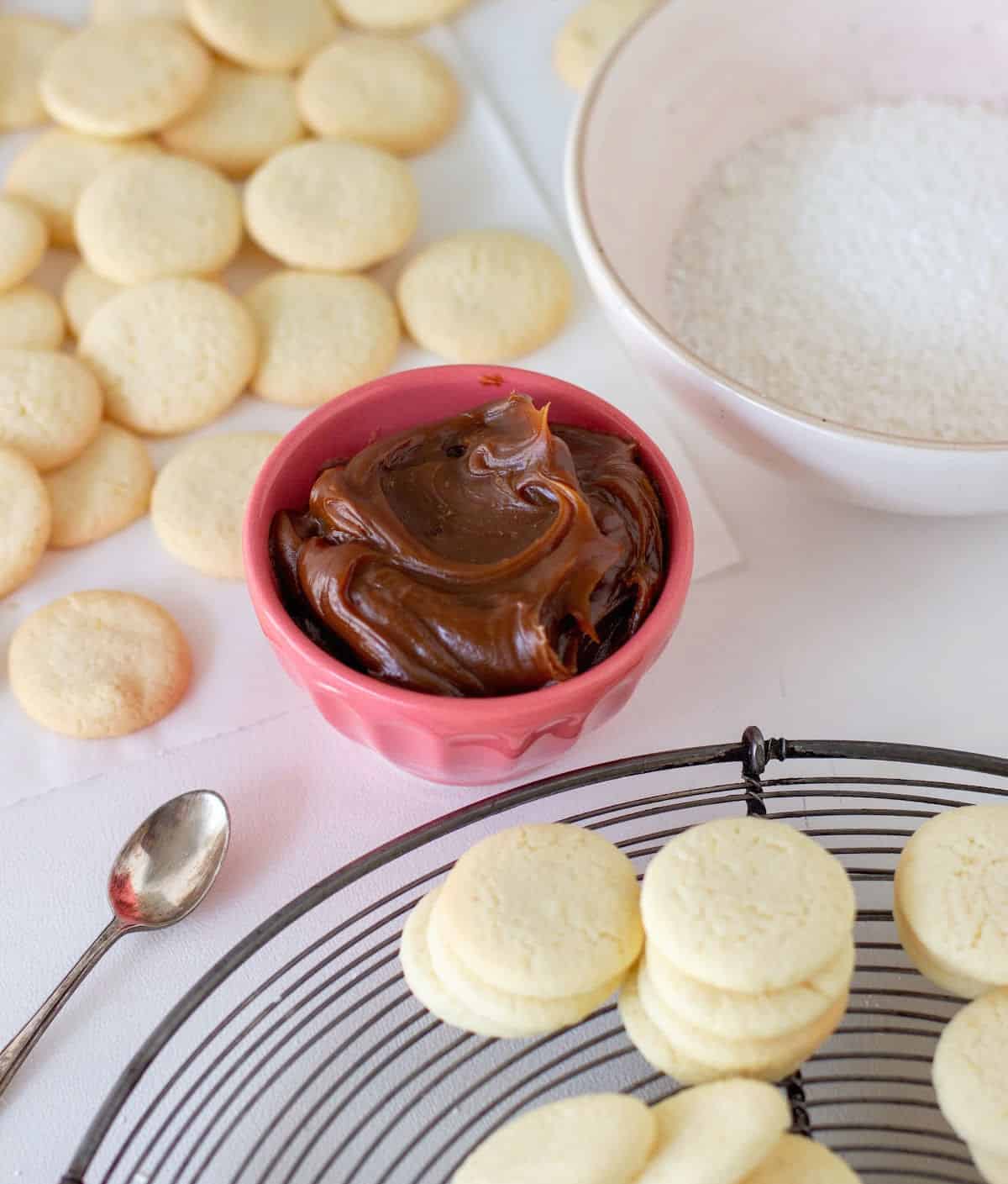
Ingredient Notes
Quantities are listed on the recipe card towards the end of this post. The Ingredients page has more details and lists the brands we use.
- Cornstarch: it's essential for that crumbly texture and a main ingredient.
- Baking powder: Make sure it's not expired.
- Cognac: You can also use brandy or whisky. It evaporates during baking and leaves behind a wonderful flavor. If you don't want alcohol, omit it and use more vanilla.
- Dulce de leche: we're using it as a filling, so we need the thicker kind, the one labeled 'repostero', which means pastry or baking. I use and recommend dulce de leche repostero Vacalin.
About the liquor: This recipe features a magic flavor trio of lemon, vanilla, and cognac (or brandy, or whisky). The synergy between these three flavors is one for the books. None of them is the star, but together, they are magic.
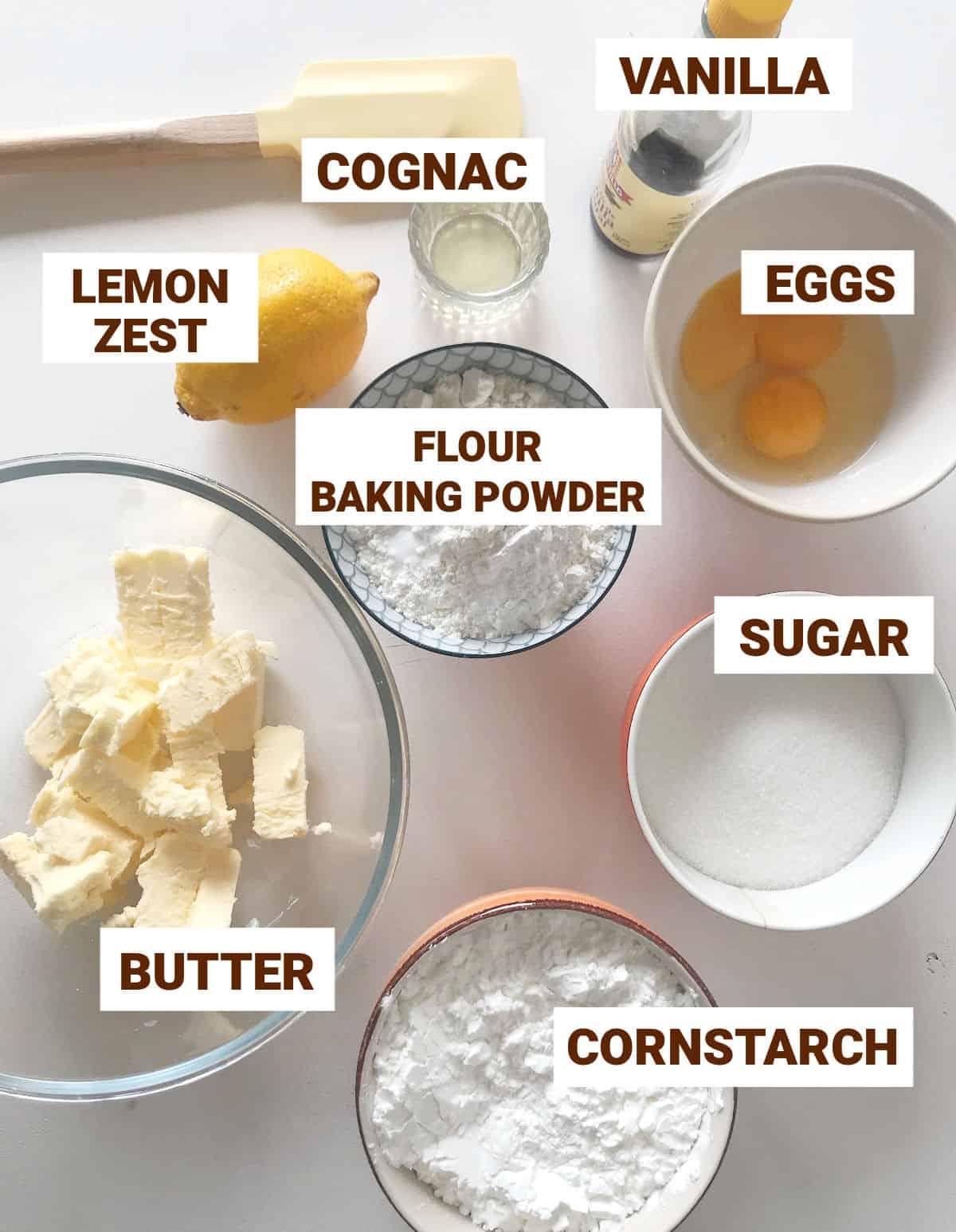
Variations & substitutions
- Don't use liquor: though I recommend using it, omit it if you can't use it. Add ½ a teaspoon more vanilla extract.
- Rolling: coconut is the traditional ingredient, but you can roll them in finely ground nuts or leave them plain.
- Fillings: being simple cornstarch cookies with an indefinite flavor, you can use different fillings like nut butter, buttercream, or a light ganache. Still, I highly encourage you to try them with dulce de leche first.
Magic flavoring
I specifically want to acknowledge the flavoring in this recipe.
It has 3 components: lemon zest, vanilla extract, and cognac (or brandy).
Though they are nothing special, when you add all three to a recipe in the right proportions, the result is fantastic!
None shine on its own but there is a deep, caramel, fresh flavor that I think is unmatched.
It's not vanilla, it's not lemon, it's not caramel, it is magic. Maybe that's stretching it a bit? Well, you can be the judge of that.
It reminds me of the flavor of red velvet cake. What does it taste like? What is so special about it? It simply has a fabulous flavor. This flavor trio reminds me of that.
The alfajores dough is a simple vanilla dough with cornstarch. It sounds easy and it is. It's all about the right proportions of flour and cornstarch.
- By hand: I use a large bowl, a whisk, and a spatula. If the butter is soft, mixing everything by hand should be simple.
- Electric mixer: you can use a handheld mixer but make sure you use it at low speed. This is not a dough that needs beating or anything like it. If you use a stand mixer with the paddle attachment, mix at the lowest speed.
The final dough is soft to the touch and neither sticky nor dry. It needs to be refrigerated before rolling.
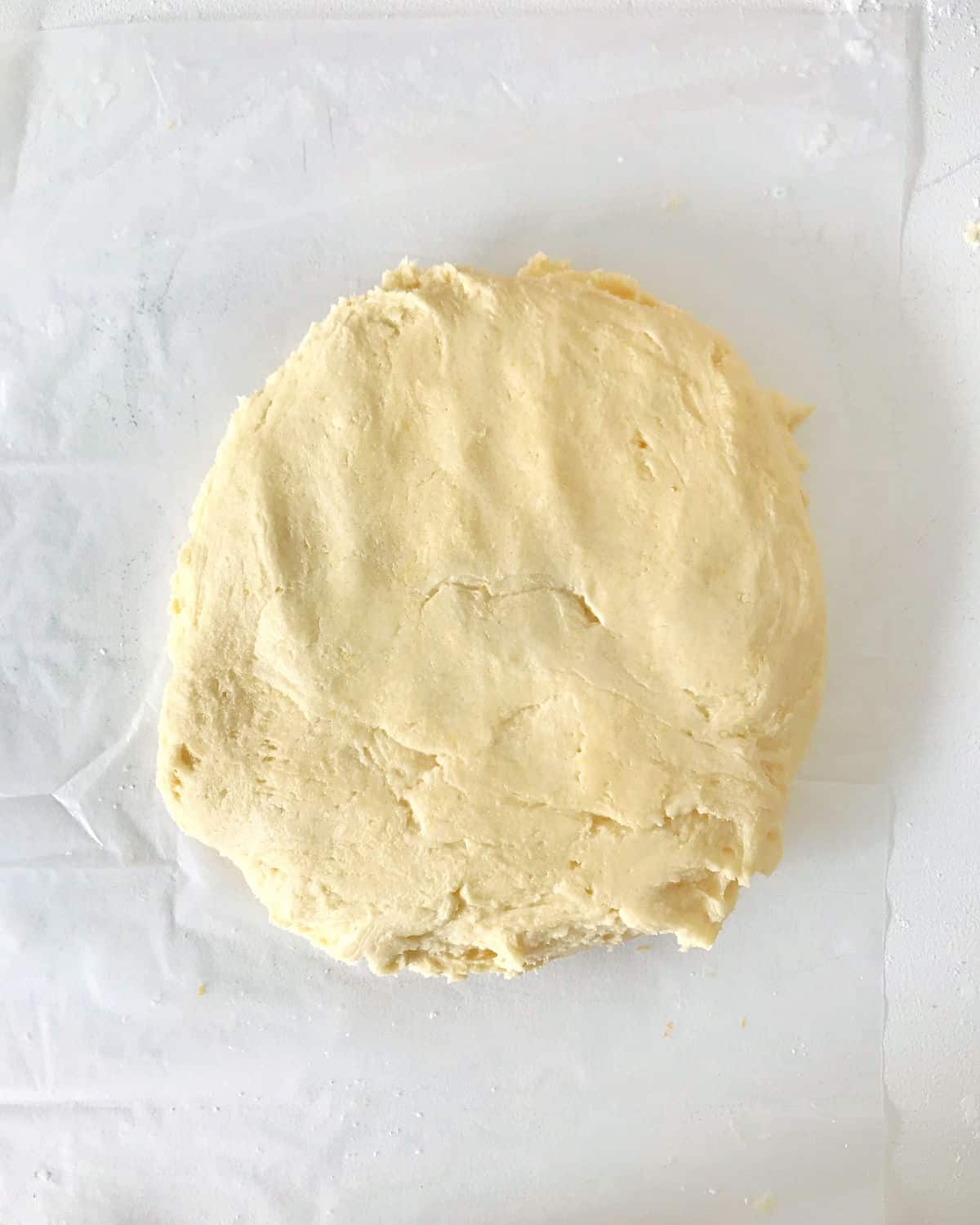
Rolling the dough
After refrigerating the dough for a few hours, it's time to roll and cut.
This dough is soft and very easy to handle. A lightly floured counter and a good rolling pin are all you need.
Cookie cutters: I use a small round cutter, which is the traditional shape of an alfajor. The dough doesn't change much during baking, and the cookies will mostly keep their shape, so you can, technically, use other forms. Still, I recommend using simple patterns.
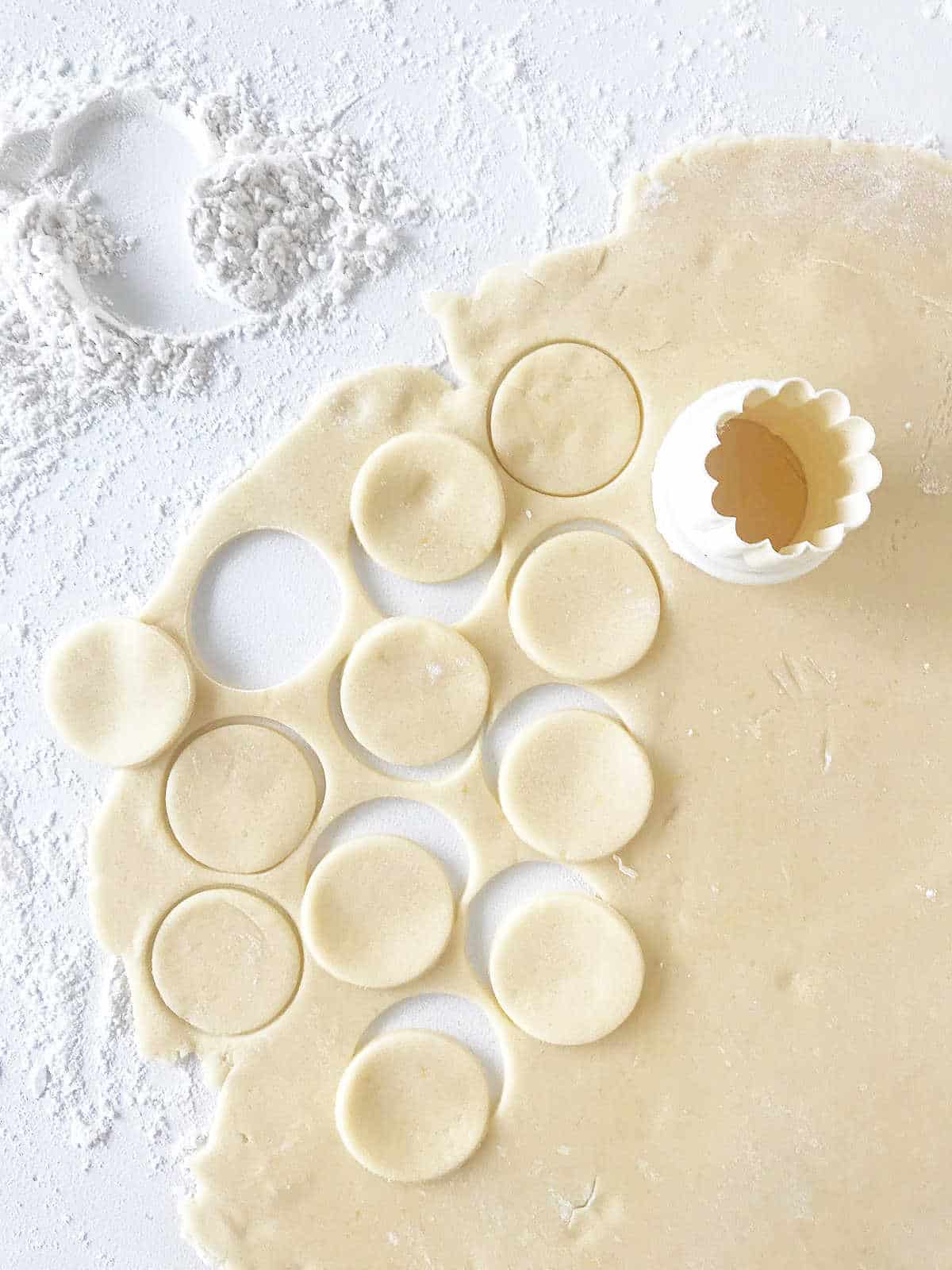
- Preheated oven: always make sure it's on before you start rolling the dough. If you forgot, place the sheets in the fridge while the oven gets to the desired temperature.
- Preparing the cookie sheets: I use parchment paper or lightly buttered sheets, both work well.
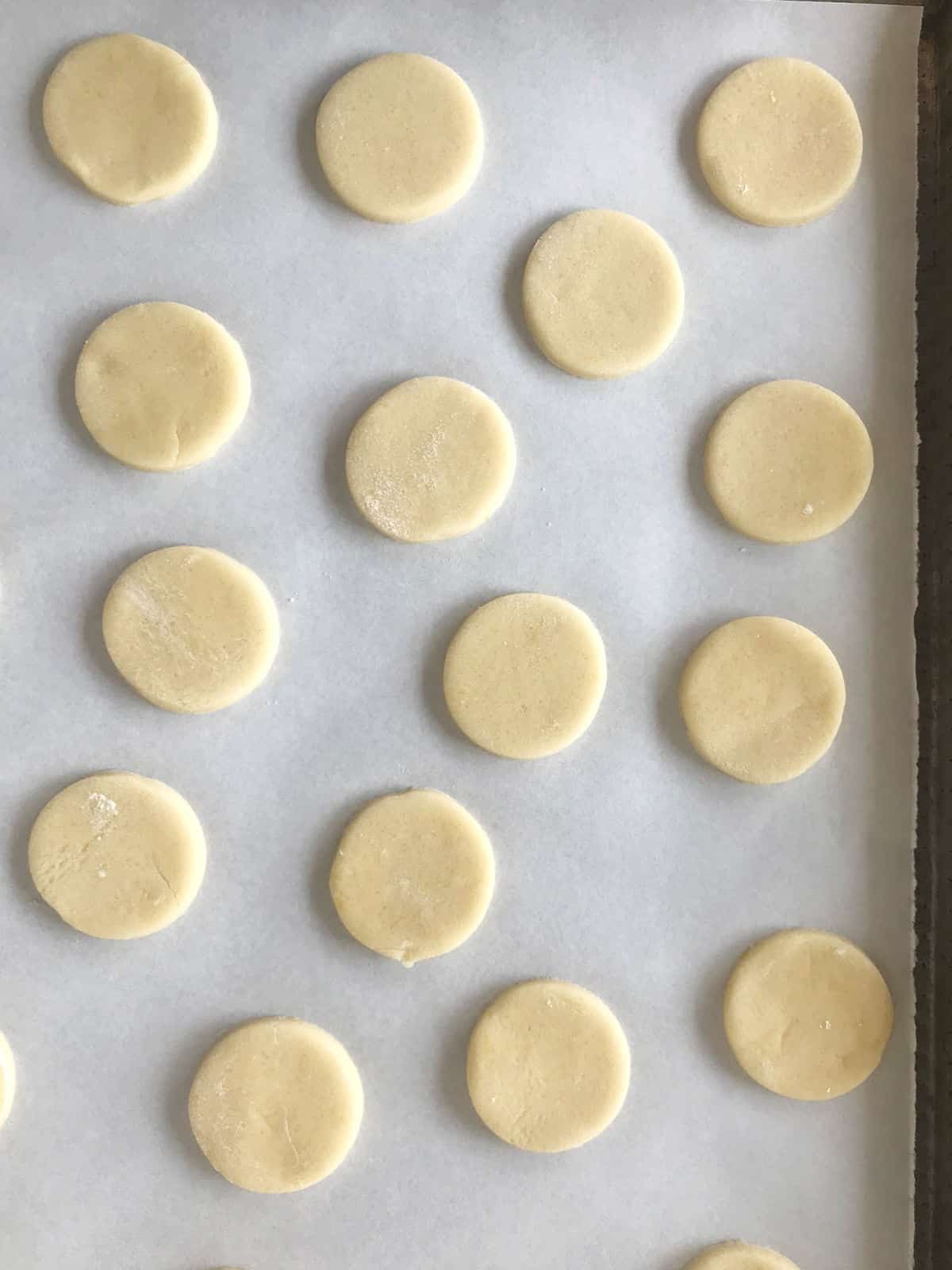
- Leave some space between the rounds, so they can grow during baking.
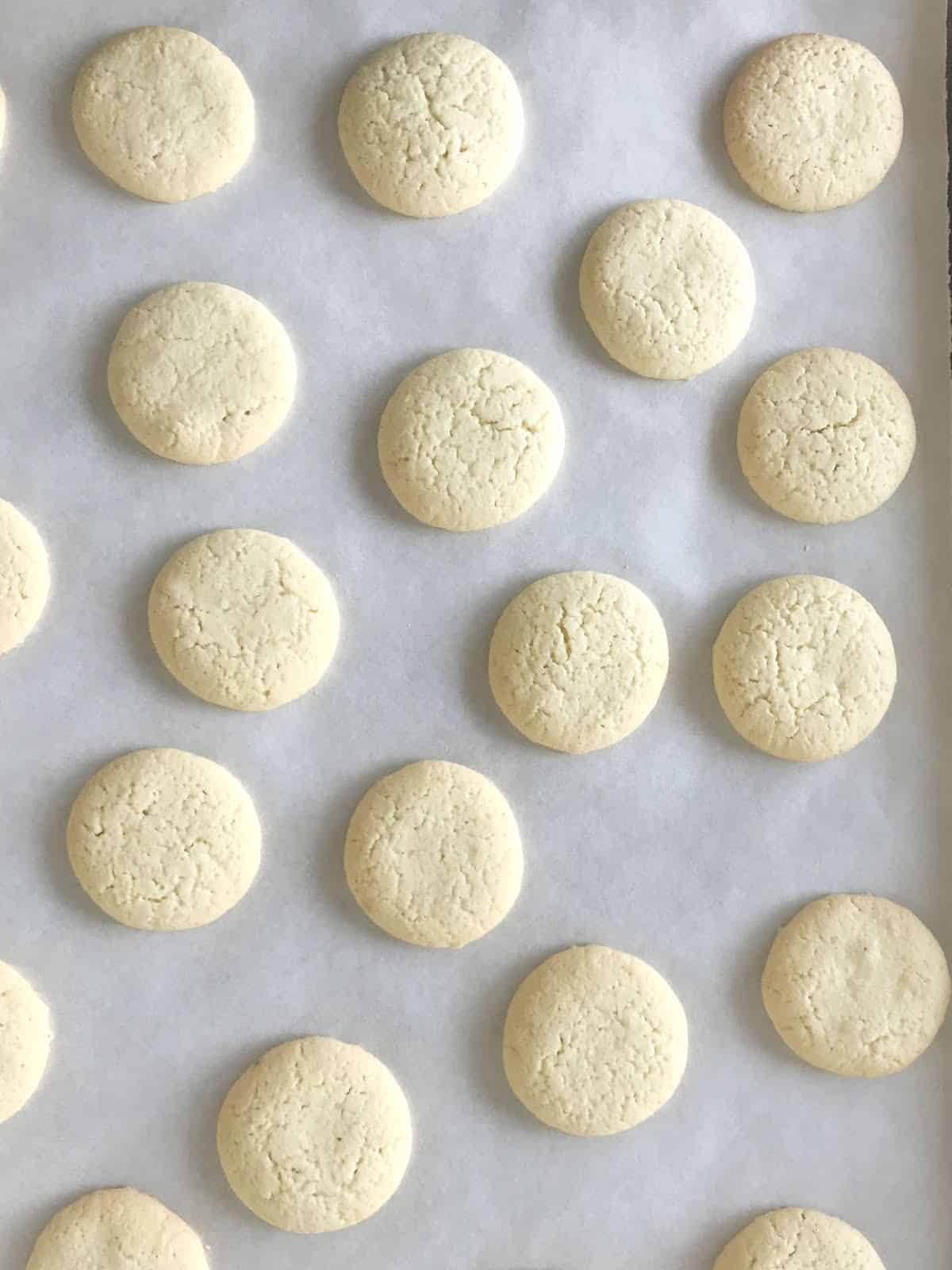
- These are light-colored, delicate cookies, so bake until barely starting to color. Don't be tempted to bake them longer, as they will be too crisp and won't soften as they should when filled.
What is dulce de leche?
Dulce de leche is a sweet milk jam, a cousin to caramel, made with milk, sugar, and baking soda, the latter being accountable for its dark color.
It takes a few hours to make and there are as many tips and tricks as there are grandmothers in this country. Each with its own recipe.
We have an abundance of commercial brands and styles, pretty much like peanut butter in the US, so we hardly make it at home.
The flavor is very sweet, similar to caramel but not quite. It does have a milk undertone, something that caramel lacks, and some might say it’s not as sophisticated, and they might be right. I’m a raving fan so my opinion is biased.
Vintage Kitchen Tip
For fillings, you need to use what we call pastry dulce de leche. It's much thicker than the regular kind. Look for the word Repostero on the label. The best one available online (that we also use here!) is Vacalin Dulce de Leche Repostero. Another good one is Veronica dulce de leche repostero. If you want to buy in bulk a great one is San Ignacio repostero (22 pounds) or Vacalin repostero (22 pounds).

Filling the alfajores
The traditional filling was, is, and will always be dulce de leche.
Piping bag: you can use it with a smooth, plain piping tip for a more even filling, or use a teaspoon and get more of an irregular filling.
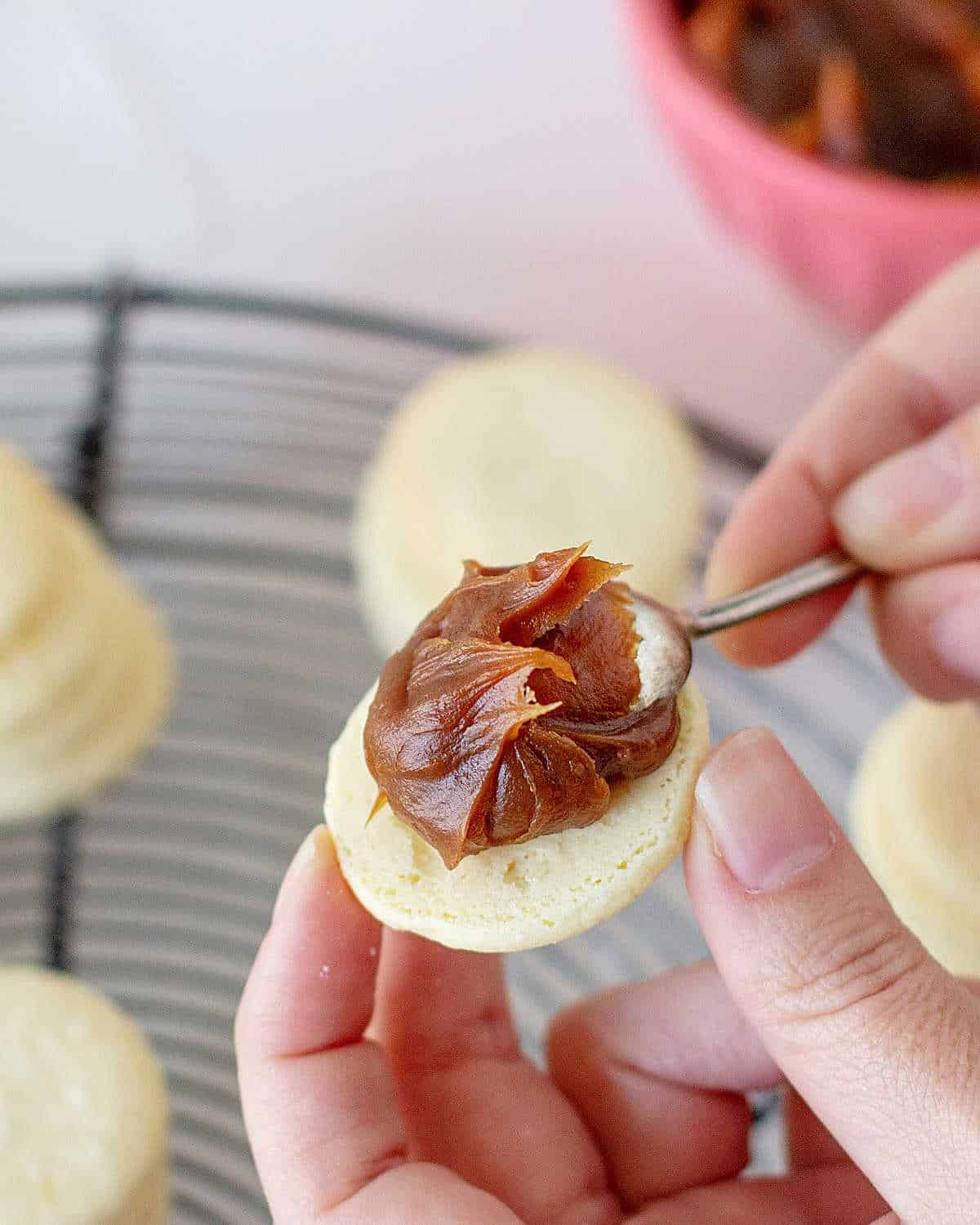
- Use a teaspoon or a piping bag for this part. Piping the dulce de leche it will be neater and you probably won't need to smooth out the edges.
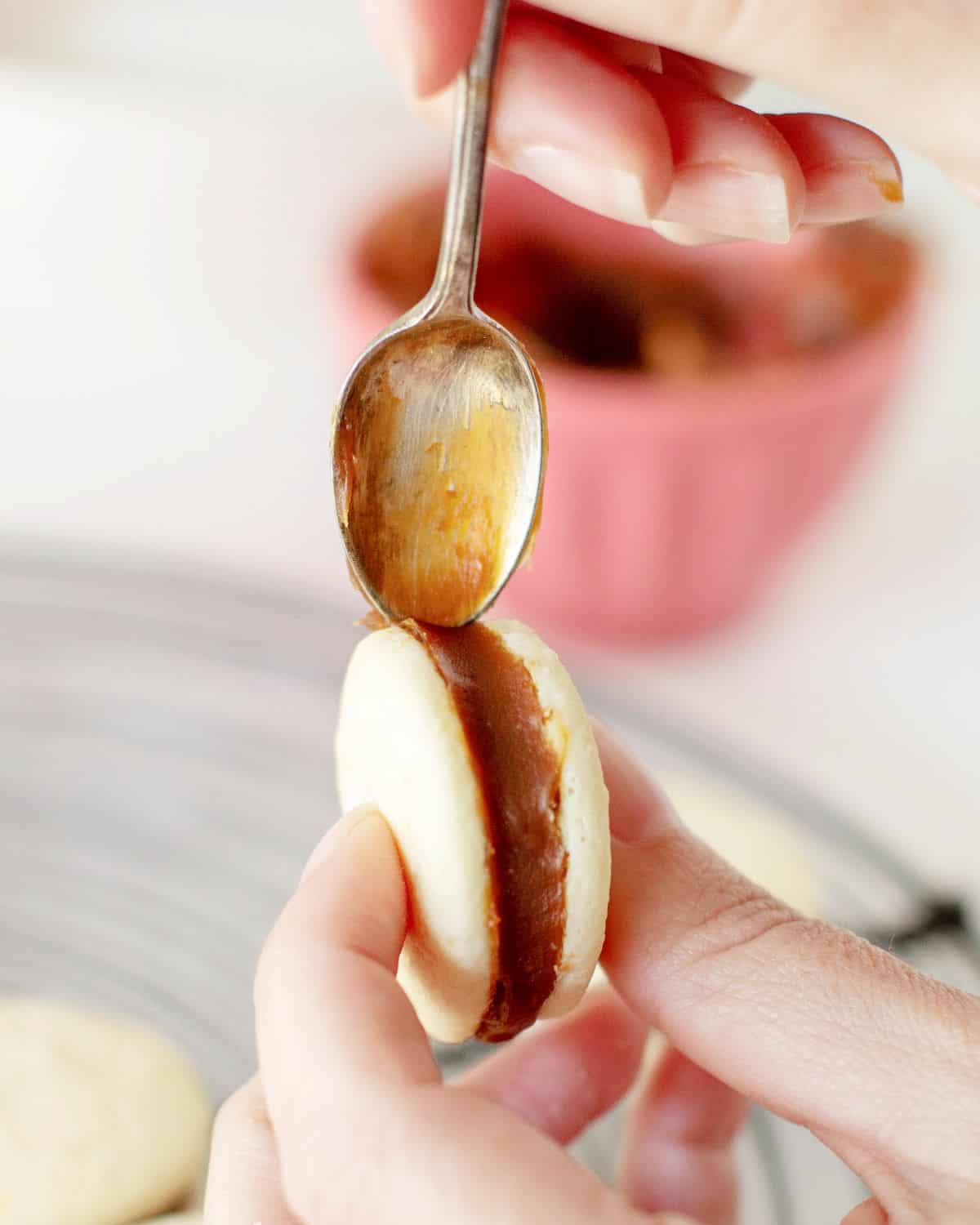
- Swipe the bottom of a teaspoon around the edges. This will even out the dulce de leche that overflowed when you pressed down the top cookie and make it easier for the coconut to adhere. You can skip this step, of course, but the alfajores will be easier to handle.
Rolling in coconut
Rolling the sides in unsweetened shredded coconut is the way these beauties roll. Coconut and dulce de leche are a match made in heaven. Truly spectacular!
Coconut border: this step, on the other hand, is completely optional. It pairs fantastically with the rest of the ingredients, but alfajores are also amazing without it. So, don't buy shredded coconut just for this.
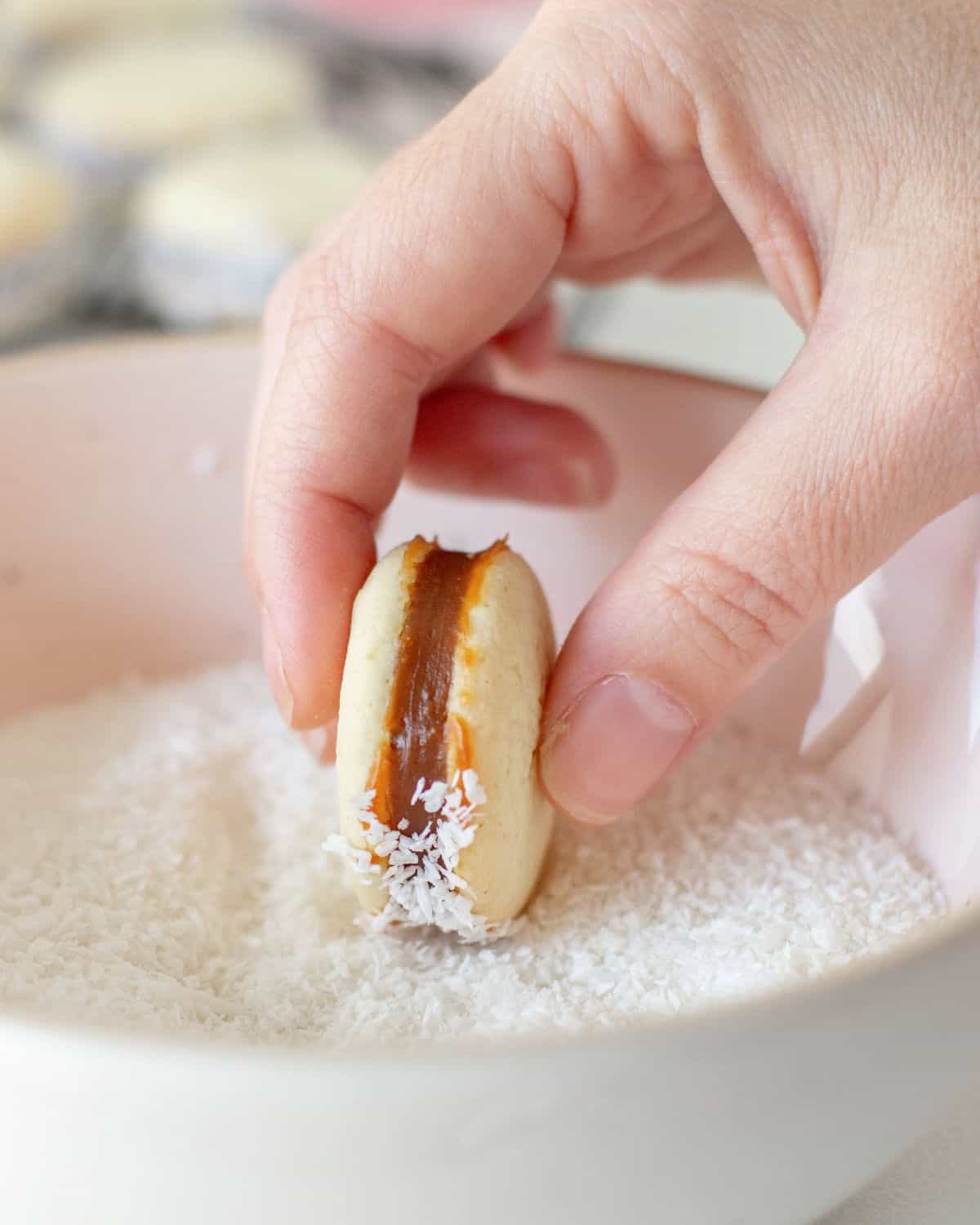
Kitchen Notes
- Organization: read the recipe first and ensure you have ingredients at the correct temperature, utensils and equipment needed, and enough workspace. This will make the process so much easier.
- Baking time: consider that all ovens and pans are different, even if they look similar. The baking time in my recipes is as accurate as possible, but it might take you more or less time. You can use a thermometer (like the OXO oven thermometer) to check that your oven is at the right temperature. I recommend tracking how your oven works and what tiny details you might need to adjust.
- Make-ahead: As with most cookie doughs, it can be made ahead and kept for 4-5 days in the refrigerator or up to a month in the freezer. Always make sure you wrap it well in clingy plastic. Otherwise, the top layer will dry out.
- Storage: The unfilled cookies can be kept in an airtight container for about a week. Fill them several hours ahead of the time you're planning to eat them so they have time to soften a little. Consider that the dulce de leche transfers moisture to the cornstarch cookies, and they will be softer when you bite into them.
- Eat them and be very happy.
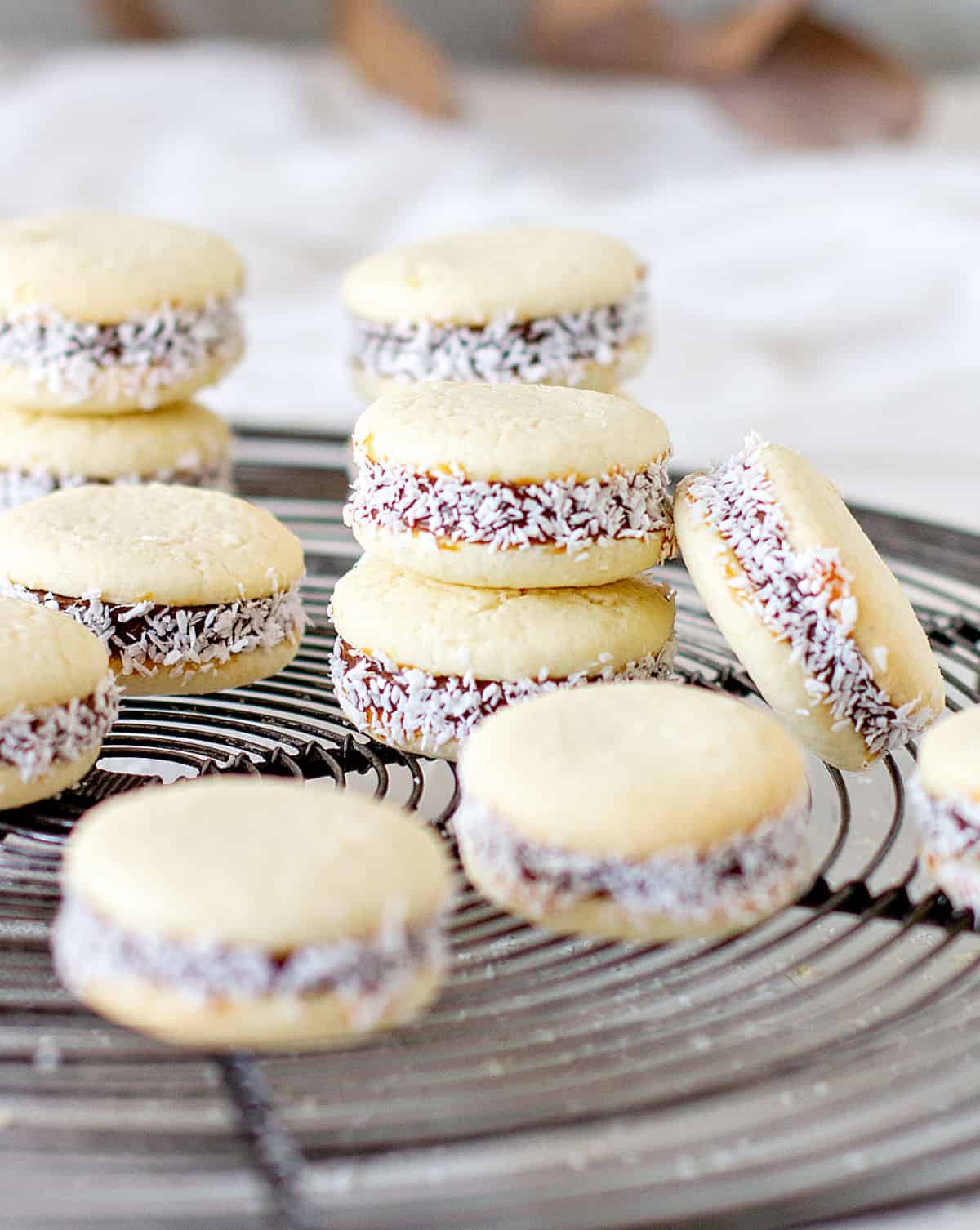
I sure do hope you try this recipe for cornstarch alfajores.
It's an easy-to-work-with dough, and they are incredibly yummy. I imagine many of you have never tried them, so trust me when I say the flavor is amazing and that they will become a favorite fast.
One last thing
If you made this recipe and loved it, you can comment below and leave a five-star ⭐️ review. Also, if you had issues, let me know so we can troubleshoot together. I appreciate honest feedback and suggestions.
You can also subscribe to our FREE email series 'Baking the Best' and our regular newsletter. Or follow and save my recipes on Pinterest.
As an Amazon Associate, I earn from qualifying purchases. Read my disclosure policy.
Related recipes you might like:
One last thing
If you made this recipe and loved it, you can comment below and leave a five-star ⭐️ review. Also, if you had issues, let me know so we can troubleshoot together. I appreciate honest feedback and suggestions.
You can also subscribe to our FREE email series 'Baking the Best' and our regular newsletter. Or follow and save my recipes on Pinterest.
As an Amazon Associate, I earn from qualifying purchases. Read my disclosure policy.
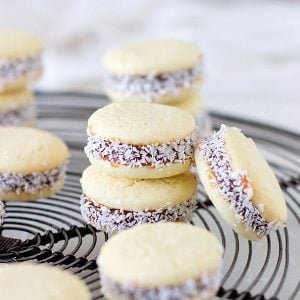
Ingredients
- 11 tablespoons unsalted butter, ½ cup + 3 tablepsoons, at room temperature
- 1 cup sugar
- 2 egg yolks, at room temperature
- 1 egg, at room temperature
- 1 tablespoon cognac, or brandy or whiskey
- ½ teaspoon vanilla extract
- ¼ teaspoon lemon zest
- 1 cup all-purpose flour
- 2 cups cornstarch
- ½ teaspoon baking powder
- pinch salt
- 1 cup pastry dulce de leche, the thick type labeled 'repostero', I use and recommend Vacalin dulce de leche repostero.
- ½ cup unsweetened shredded coconut, for rolling (optional)
Instructions
- Mix 11 tablespoons unsalted butter and 1 cup sugar in a large bowl, until very creamy, using a spatula, handheld mixer, or a wooden spoon.
- Add 2 egg yolks and 1 egg and mix well to incorporate.
- Add 1 tablespoon cognac, ½ teaspoon vanilla extract, and ¼ teaspoon lemon zest. Mix well.
- Add the sifted 1 cup all-purpose flour, ½ teaspoon baking powder, pinch salt and 2 cups cornstarch gradually, mixing very well until no streaks of dry ingredients remain. The final dough will be very soft and silky but not sticky.
- Pat it into a disc, wrap the dough in plastic wrap or freezer sheets, and let it rest in the refrigerator for 30 minutes, like any sweet dough. At this point, it can be refrigerated for 3 days or frozen for a month, always well wrapped to prevent dryness.
- Preheat oven to 325°F (170°).
- On a floured surface, roll dough to ½ cm thick (about ¼ inch).
- Using a round cookie cutter, cut circles and place them on a buttered cookie tray or use a Silpat. In my experience, they tend to stick when using parchment paper, but then, all papers are different depending on where you live. Thickness and size are totally up to you; I suggest you try different combinations and see which one works best for your taste.
- Gather the scraps, roll them again and cut more alfajores cookies until you use up all the dough.
- Bake for 10-12 minutes or until barely starting to color. Let cool completely on a wire rack.
- Put about a tablespoon of dulce de leche (with a spoon or with a piping bag) and fill one round, flat side up. Press lightly with another round, flat side down forming the alfajores.
- With the back of a small spoon, wipe any dulce de leche that has overflowed. This will leave a path for the coconut to stick.
- Put ½ cup unsweetened shredded coconut on a small plate or bowl and roll the sides of the alfajores until coated. Or leave the sides plain.
- Eat them and be happy.


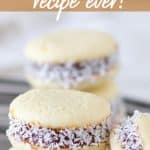


Mirna says
I have done many times using your receipt and I love the texture and the sweetness it is just right on the dot, my friends love it, it is deliciously Rico!
Thank you for sharing to us.
Lauren says
I’ve used your alfahore recipe a few times now & it is the most reliable. Very consistent results. I’m in Australia & dulce de leche is not readily available here. I make my own by simmering a tin of condensed milk for 3 hours. It’s firm enough to hold well. These biscuits are always a hit at parties. Thanks for sharing!
Ana says
Delicious
Serena Kidder says
I’m going to make these for my Spanish class for our week on Argentina. Is it typical to eat these with mate? And do Argentines put sugar in their mate?
Paula Montenegro says
Hi Serena, I love it! Yes, we do eat them with mate sometimes. As for the sugar, it's a matter of taste. And it's very divided. If you have it one way, you usually loathe the other. I drink mate without sugar, bitter mate as we call it. Whatever works for you.
Serena Kidder says
So I fed them to my class, and they were a hit. My own family liked them too. I want to make them again once I can source cognac, but is there a way to make repostero dulce de leche at home? I was stingy spreading my repostero and I used half a kilo on one batch, so I can’t make it a habit to be ordering it from Argentina 🙂
Paula Montenegro says
So happy to know they turned out so well Serena! Homemade dulce de leche (regular or repostero) is different in texture from the ones you buy. And it's hard to replicate repostero. But it's available on Amazon, and they have Vacalin (brand) that is the one most of us use here. The link is in the ingredients list section of the Alfajores post.
Kalen says
There was not a single measurement
Paula Montenegro says
Hi Kalen, what measurements are you referring to? They are all in the recipe card at the end of the post. You have the jump to recipe button at the top that takes you directly to it.
Karen says
Perfection- the doneness made me anxious but they turned out well!
Marjorie Robertson says
Great recipe . However. 22 Tbs of butter is not 1/2 C closer to 1 C
Paula Montenegro says
Hi Marjorie, the recipe calls for 11 tablespoons and that is 1/2 cup plus 3 tablespoons. It’s all in the recipe card. Have a great Christmas!
Gabi says
These were amazing! I do have some of the cookies leftover without dulce de leche filling. Can I freeze them, until I want to make more assembled cookies?
Paula Montenegro says
Hi Gabi! They will keep for several days in an airtight tin or ziploc bag. For longer storage you can freeze them, but it's not my favorite way.
kim says
hello! i am midway through this recipe and realised that even though i separated the eggs i still added the whites ♀️ my dough is very sticky as a result. do i need to start again?! what can i do to salvage my batter? i’ve made a double amount as well. disaster! please help!
Paula Montenegro says
Hi Kim! You can add more flour to compensate for the extra moisture from the whites. Be careful as too much might make them tough. Then try a few cookies and see how you like them. There's not much else you can do at this stage.
Patricia says
This tastes like the cookies we made when we were little over 50 years ago. My mom was Argentinian and loved cooking from the Dona Petrona cookbook. I remember she had several of them in the kitchen. I have no doubt it was the same recipe.This made me smile.
Sydney says
I’m making these, and my dough is super crumbly, like sand! I’m certain I put in the exact measurements of everything. I can’t get it to come together! What should I do?
Paula Montenegro says
Hi Sydney, add a teaspoon at a time of milk until it's supple and soft, very manageable to roll. But don't make it wet or it'll expand too much during baking.
Ashley Davis says
What brand of cognac do you recommend?
Paula Montenegro says
Hi Ashley, I live in Argentina and use Curvoisier, the less expensive ones. Or Reserva San Juan but I don't think it's available outside here. Brandy also works and there are many brands. You can also see if you find cognac or brandy extracts or essence made for cooking.
Carm morelli says
I have tried these cookies from a coffee shop and they are delicious. I have wrapped caramels and wonder if I could use them as the filling ? Thankyou
Paula Montenegro says
Hi Carm, I never used caramels so can't talk from experience. My feeling is that the consistency of the filling will not be the right one as melted caramels are stickier than dulce de leche. But you can try with a small amount and see how it goes.